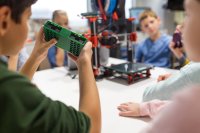Making Makerspaces Work for All Students
Makerspaces can energize students as problem solvers, and they should be accessible to students with physical disabilities.
Your content has been saved!
Go to My Saved Content.Makerspaces are exciting playground spaces in schools where educators can foster creativity, innovation, and design skills. Often these spaces are filled with high-tech gadgets for 3D printing, robotics, and circuitry experimentation.
While there’s infinite potential in these spaces, educators must design for inclusion of all students, including those with sensory and motor disAbilities, in the physical spaces and the learning activities within. (In this article we use the term disAbilities, with a purposeful capitalization of the A to keep our focus on the abilities of students and to mirror the language we used in a pilot college course we developed.)
Designing for Inclusion With Preservice Educators
Ensuring inclusive design can begin through connecting with preservice educators as they explore and emerge as professionals during teacher preparation.
By empowering new educators to be prepared to design for inclusion, we have the potential to change the direction of the STEM (science, technology, engineering, and math) fields. Individuals with disAbilities are not entering these fields—less than 10 percent of those who have a disAbility diagnosed early in life and only slightly more than 15 percent of those diagnosed in their high school years enter these fields.
But individuals with disAbilities can make unique contributions to the fields of making and STEM. Often generic design—of door handles, lockers, and pencils—is for the average student, and an individual with a physical disAbility must modify that design. So these student have practice with the concepts of tinkering, making, and iterative design in their day-to-day life. For instance, a student might modify a pencil grip, or device a personalized process for packing up their backpack. Educators can make space for these contributions.
In order to ensure that teachers are ready for this paradigm of inclusion, we sought to work with preservice educators in the college classroom. This process started with our own paradigm shift when we purposefully redesigned a course to empower preservice teachers to contemplate how to use high-tech design and fabrication to increase access and equity in their future classrooms. We piloted a 3D design-build project in a 200-level Assistive Technology course at the University of Maine at Farmington for students seeking to become certified as special educators.
The students explored, used, and hacked a huge range of products designed to support daily life and learning for students with disAbilities. We also asked them to explore off-market uses for the products, in part of inspire a mindset of problem-solving.
We wanted to empower these future educators to create solutions as well, so we introduced 3D design and fabrication. Almost none of the students had prior experience with these tools. With limited time available, the students worked in teams on a simple project: designing a new tactile tile for an augmentative and alternative communication (AAC) device and then programing the tiles to learn how the modified AAC worked. (AAC devices often provide pictures, sounds, or symbols that a child with a disAbility can use to express their opinions and answers at home and school.)
Next Steps
Educator preparation is a vital link in shifting the future of makerspaces to realize a more inclusive audience. We’re excited about the potential of this project to serve as a model for others. We’d offer the following as guidelines for beginning such a shift.
First, we believed it was important for preservice educators to have hands-on experience as makers to show them the possibilities of such tools. We believe it will be essential in future projects to empower individuals with disAbilities to design and build their own projects, and are working to bring this idea to life in our curriculum materials center and through our assistive technology collection.
Additionally, preservice educator programs can focus on user-centered design for learning. User-centered design considers each person’s individual needs within a situation, with input and feedback from the person. These concepts translate well as strategies for educators to engage with all students and involve them in taking ownership for learning.
As we expand past the pilot project and have preservice teachers host and work with others to fabricate real-life solutions, we’re very aware of the need to examine the physical space where 3D printers and other maker tools are located. Educators can advocate for locating makerspaces in places that are central, highly visible, and accessible to all. Educators can also explore mobile furniture and adjustable-height workspaces as potential ways to increase access to these tools.
While space, tools, and accessibility are important for designing inclusive makerspaces, we also encourage educators to design the user experience such that all individuals are invited to participate in the design and testing of prototypes and models. It’s important that when students are designing for other users in the makerspace, they learn how to ask for input and feedback in the process. Nurturing the skills of listening, giving feedback, and opening doors between individuals is perhaps one of the most powerful elements of an inclusive makerspace.
Makespaces hold tremendous potential in schools and communities to energize students as designers, thinkers, and problem solvers. Makerspaces also have the potential for educators and students to place our shared community at the center of the work, and design more inclusive strategies to unite and support each other. However, if we are to realize this potential, educators must design for inclusion.
